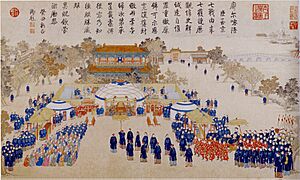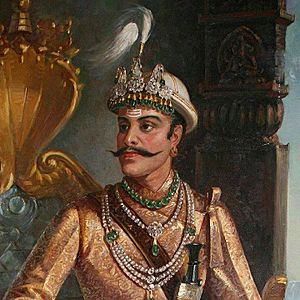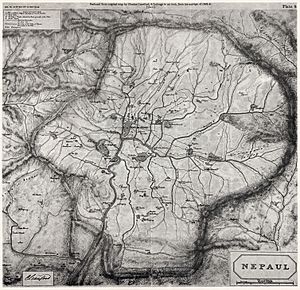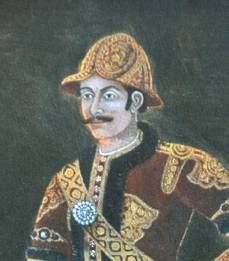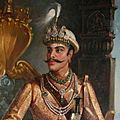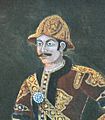Damodar Pande facts for kids
Quick facts for kids
Sri Sri Sri Mulkaji Saheb
Damodar Pande
|
|
|---|---|
| श्री श्री श्री मूलकाजी साहेब दामोदर पाँडे |
|
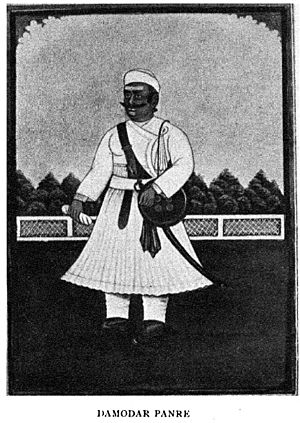 |
|
| Mulkazi (Prime Minister) of Nepal | |
| मूलकाजी साहेब | |
| In office February 1803 CE – March 1804 CE |
|
| Monarch | Girvan Yuddha Bikram Shah |
| Preceded by | Bakhtawar Singh Basnyat |
| Succeeded by | Ranajit Pande |
| Commander-in-Chief of Nepal Army | |
| In office TBD – March 1804 |
|
| Personal details | |
| Born | 1752 CE |
| Died | March 13, 1804 CE Bhadrakali, Kathmandu |
| Nationality | Nepali |
| Children | 5 sons: Ranakeshar Pande, Ranabam Pande, Ranadal Pande, Rana Jang Pande, Karbir Pande |
| Parent |
|
| Military service | |
| Allegiance | |
| Rank | General |
| Battles/wars | Sino-Nepalese War (I&II) |
Damodar Pande (Nepali: दामोदर पाँडे) (1752 – March 13, 1804) was a very important leader in Nepal's history. He was like the Prime Minister (called Mulkaji) from 1803 to 1804. He was also a brave general who fought in wars. Damodar Pande was the youngest son of Kalu Pande, another famous leader. He was born in 1752 in a place called Gorkha. He played a big part in the wars between Nepal and Tibet, and later with China.
After Damodar Pande's death, Ranajit Pande became the Chief Kaji. Other important people like Bhimsen Thapa and Sher Bahadur Shah also took on big roles in the government.
Contents
Who Was Damodar Pande's Family?
Damodar Pande was born in 1752. His father was Kalu Pande, a well-known Kaji (a high-ranking official) from Gorkha. Damodar Pande belonged to a Hindu family from the Chhetri group. His older brother was Vamsharaj Pande. Damodar Pande had five sons. One of his sons, Rana Jang Pande, later became a top leader in Nepal.
Damodar Pande and the Sino-Nepalese War
Damodar Pande was a key commander in the wars between Nepal and Tibet, which later involved the powerful Qing Empire of China.
First Invasion of Tibet (1788)
In 1788, Nepal's leader, Bahadur Shah of Nepal, sent troops to attack Tibet. Damodar Pande and Bam Shah led these Gorkha troops. They went deep into Tibet and won a big battle at Shikarjong.
After this, the Tibetan leaders asked for peace talks. The Gorkha troops then moved back towards Kuti and Kerung.
When the Chinese Emperor, Qianlong Emperor, heard about Nepal's invasion, he sent a large army to Tibet. The Chinese general learned about the situation and decided to stay until the problem was solved.
Nepal and Tibet met for peace talks in 1789. Tibet was blamed for the conflict and had to pay Nepal for the war damages. They also agreed to pay Nepal a yearly tribute of 50,001 rupees. This was called the Treaty of Kerung. Nepal returned the areas they had taken. However, Tibet stopped paying the tribute after the first year, which led to more fighting.
Second Invasion of Tibet (1791)
Because Tibet stopped paying, Bahadur Shah sent troops again in 1791. Damodar Pande led a group to Kuti. He attacked a place called Digarcha and took valuable items from a monastery. He also arrested a minister from Lhasa and returned to Nepal.
When the Qianlong Emperor heard this, he sent a huge army of 70,000 soldiers to defend Tibet. So, in 1792, the war between Nepal and Tibet became a war between Nepal and the powerful Qing Empire of China.
The Chinese Empire demanded that Nepal return the stolen property and a Lama (religious leader) who had sought safety in Nepal. Nepal refused. The Chinese army then marched towards Nepal's capital, Kathmandu. The Nepalese troops fought bravely but were greatly outnumbered. Both sides suffered heavy losses.
At the same time, Nepal was fighting on other fronts. The Kingdom of Sikkim was attacking from the east, and a war with Garhwal continued in the west. Also, some kingdoms within Nepal were rebelling. These problems made it very hard for Nepal to fight the Chinese army. Nepal asked the British East India Company for help, but they wanted a business deal in return, so Nepal didn't get the weapons.
The Chinese army faced a big challenge when they tried to cross the flooded Betrawati River near Nuwakot. On September 19, 1792, Nepalese troops launched a surprise attack. They used a clever trick: they tied lit torches to trees and flaming torches to the horns of animals, driving them towards the enemy. This made the Chinese army think there were more Nepalese soldiers than there actually were. The Chinese army suffered a defeat, but they still remained in Nepal.
The war reached a standstill. Nepal's resources were low, and they needed to focus on their western borders. So, Nepal signed a treaty with China. This treaty required Nepal to send gifts to the Chinese Emperor every five years.
The Treaty of Betrawati (1792)
On September 19, 1792, about 10,000 Chinese troops advanced from the Betrawati River. There were three forts nearby, and Damodar Pande was in charge of one of them, Chokde. Fierce fighting took place, and the Nepalese forces pushed the Chinese troops back to the river.
The Chinese General, Tung Thyang, was very strict with his retreating soldiers. Many Chinese soldiers died from falling into the river or from Nepalese attacks. About 1000 to 1200 Chinese troops were killed. Seeing no hope of winning, the Chinese General decided to make a peace treaty with Nepal.
The King of Nepal, Rana Bahadur Shah, then ordered Kaji Damodar Pande to sign a treaty with the Chinese Emperor. This was to stop the fighting and keep peace. The King trusted Damodar Pande to make the best decisions for Nepal.
Damodar Pande's Rise to Power (1794-1804)
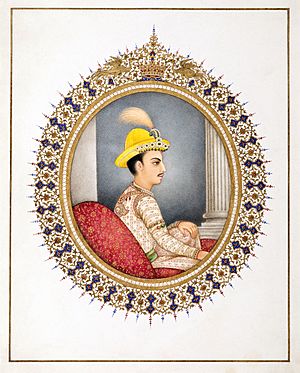
In 1794, King Rana Bahadur Shah became old enough to rule on his own. He changed the government, removing his uncle, Bahadur Shah. Damodar Pande became the most important Kaji among the new officials.
In 1799, King Rana Bahadur Shah was very upset by the death of his mistress. His behavior became unpredictable, and the people forced him to give up his throne. He handed the crown to his one-and-a-half-year-old son, Girvan Yuddha Bikram Shah. Rana Bahadur Shah then left for a city called Banaras with some followers, including Bhimsen Thapa.
Becoming Mulkaji (Prime Minister) of Nepal
While the young King Girvan Yuddha Bikram Shah was still a child, Damodar Pande took charge of the government as the Mulkaji, or Prime Minister. This meant he had full control over how the country was run and how it dealt with other nations. He wanted to protect the young king and keep his unpredictable father, Rana Bahadur Shah, away in Banaras.
Damodar Pande always tried to protect King Girvan Yuddha Bikram Shah. However, on March 4, 1804, the former King Rana Bahadur Shah returned to Nepal. He took over the top leadership position.
Damodar Pande's Decline from Power
Earlier, in 1801, another important Kaji named Kirtiman Singh Basnyat was killed. Damodar Pande was wrongly accused of this crime. Many officials were jailed or even killed because of rumors. Bakhtawar Singh Basnyat, Kirtiman Singh's brother, then became the Chief Kaji.
Later, in December 1802, King Rana Bahadur Shah's wife, Rajrajeshowri, took over as regent (ruler for the young king). She was pressured to pay off the former King Rana Bahadur Shah's large debts from his time in India. The Nepalese court also thought it would be better to have Rana Bahadur Shah in Nepal rather than in British-controlled India.
Rajrajeshowri changed the government in February 1803, making Damodar Pande the Chief Kaji. The British representative, who was trying to interfere, left Kathmandu. This showed strong anti-British feelings. Because of this, the British ended their diplomatic ties with Nepal in January 1804. This also allowed the former King Rana Bahadur Shah to return to Nepal without any conditions.
Return of Rana Bahadur Shah
As soon as Rana Bahadur Shah heard the news, he and his group headed for Kathmandu. Some troops sent by the Kathmandu government to stop them actually joined the former King. Damodar Pande and his men were arrested at Thankot.
After Rana Bahadur Shah regained power, he sought revenge on those who had tried to keep him away. He sent his wife, Rajrajeshhwori, away. Damodar Pande, along with his two eldest sons, was killed on March 13, 1804. Other people who had supported Damodar Pande were also punished.
Those who had helped Rana Bahadur Shah return were rewarded with high positions and wealth. Bhimsen Thapa became a Kaji, and Ranajit Pande became the Mul Kaji.
Damodar Pande's Death
On March 1, 1804, the former King Rana Bahadur Shah returned and took control of the government. On March 13, 1804, Damodar Pande was killed along with his two eldest sons, Ranakeshar and Gajkeshar. This happened after they were imprisoned in Bhadrakali.
Images for kids


